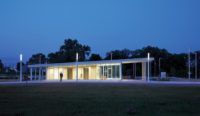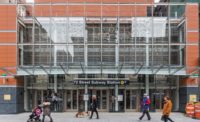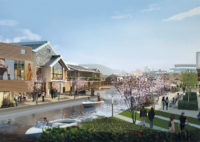Downtown sports stadiums are a mixed bag. While they can attract tourism dollars and spur development, they aren’t always good neighbors aesthetically. Many rise abruptly, big and opaque, looking like downed spaceships.
Not so CHS Field, in the Lowertown Historic District of St. Paul. The $64 million, 7,000-seat ballpark is the new home of the locally beloved minor league team the St. Paul Saints. The porous park, designed by Minneapolis-based Snow Kreilich Architects, with Ryan Architecture + Engineering (A+E) as architect of record and AECOM as the sports architect, has a street-level entrance and concourse, while the field and seats dip down to 17 feet below grade, providing views of the surrounding neighborhood and, to the south, the Mississippi River and its bluffs.
Additional Content:
Jump to credits & specifications
Part owned by the actor Bill Murray, the team is known for its community involvement, sharing its love of baseball with kids, and, not surprisingly, its humor—it celebrated National Hot Dog Day with a parody of former U.S. congressman from New York Anthony Weiner. The Saints’ previous home was the 30-year-old Midway Stadium, owned by the city and torn down in 2015. Though many, including the team, were fond of its quirks, it was outdated.
The site of a shuttered Gillette factory in Lowertown was chosen for a replacement ballpark. This was the design team’s first challenge. Chemicals from the hair products manufactured there had leached into the ground and created one of the most polluted sites in the Twin Cities. Architect Julie Snow, founding partner of Snow Kreilich, says it went from “brownfield to ballpark. Nobody knew how contaminated it was when we started. That was a big ‘hello.’ ” The architects oversaw the removal of the adulterated soil and, though they razed most of the factory, were able to repurpose 99 percent of the rubble. They saved some of the foundation and then crushed the rest of the building for construction material, the field base, retaining walls, and pier foundations.
Another challenge was addressing concerns from the community that crowds, noise, light pollution, and parking needs would spill over from the park. Snow alone attended 17 community meetings to help assuage fears.
The friendly new ballpark defers—and refers—to the surrounding early 19th-century warehouse structures. From the street, visitors and passersby can see inside through open and glass-enclosed steel-framed concourses that hug the field, their fascia clad in dark masonry and steel. These busy circulation areas, covered with warm cedar ceilings, house the park’s concessions, restrooms, club, suites, and press room. The offices are tucked below grade.
The stadium is a source of pride in the community. “Of course there were debated moments, but now that it is all said and done, the ballpark and the neighborhood display a harmony that is rare and highly complementary,” says architect Mike Ryan, president of Ryan A+E. “I believe we stretched $64 million to realize over $100 million in value, and the results speak for themselves.”
According to the Saints, the new field, which has 1,000 more seats than Midway Stadium, increased the team’s revenue by 100 percent between 2014 and 2015, with 400,000 visitors. Staff, interns, and players now have a streamlined and engaging workplace. The park is also aiming to become one of the greenest ballparks in America by recycling, reusing rainwater, and harvesting electricity from a 100kW solar array. Above all, the CHS Field has become a community asset during off hours, open to the public free of charge, so people can use the concourse as a walking track or take advantage of the new dog park to the north of the field and events lawn to the east.
“It’s a wonderful, historic, relevant place,” says Tom Whaley, executive vice president of the St. Paul Saints. “Integration is what will drive the long-term success of the ballpark—what it means to our fans, the neighborhood, and the team.” Adds Mike Veeck, team co-owner: “On July 3rd, there were 10,000 people in the ballpark and 4,000 out on the street. You couldn’t tell where the ballpark ended and the farmers’ market started. That’s what has created such a sense of community.”
Back to Good Design Is Good Business 2016
PeopleArchitect: Snow Kreilich Architects Inc. Design Architect: Snow Kreilich Architects Architect of record: Ryan A+E Sports Architect: AECOM Engineers: Mechanical Engineer: Schadegg Mechanical, Inc. Consultants Design landscape architect: Bob Close Studio General contractor: Ryan Companies Photographer: Paul Crosby & Christy Radecic Client: City of St. Paul and the St. Paul Saints Size: 347,000 square feet Cost: $63 million Completion date: May 2015
|
ProductsStructural System Structural System: http://www.cmf-inc.com provided structural steel, http://www.amerectinc.com erected the structural steel Exterior Cladding Masonry: Masonry: Custom block supplied by Amcon Block http://www.amconblock.com, http://sericeconstruction.com installed masonry Metal panels: Metal: MG McGrath Inc. Miscellaneous Metals were by http://metro-mfg.com see exterior wall systems for metal panels by http://mgmcgrath.com Precast concrete: http://www.ryancompanies.com for placement and finishing, http://www.avrconcrete.com - supplied ready-mix concrete, Wood: Ceilings (wood): MG McGrath Inc. http://mgmcgrath.com installed western red cedar with clear finish as furnished by Weekes Forest Products http://www.weekesforest.com Other cladding unique to this project: Metal: MG McGrath Inc. Miscellaneous Metals were by http://metro-mfg.com see exterior wall systems for metal panels by http://mgmcgrath.com Glazing Glass: Empirehouse, Inc. http://www.empirehouse.com; Oldcastle BuildingEnvelope (glass, storefront, curtainwall and operable windows at press/media area); Wasco (skylight); Insulgard (ticket windows) Interior Finishes Acoustical ceilings: Acoustical System: http://www.archsalesmn.com Armstrong for ACT ceilings, Sonex for the acoustic foam material in the Saint’s office on the Service Level, MG McGrath Inc. http://mgmcgrath.com installed custom acoustic wood ceiling in Securian Club Room Cabinetwork and custom woodwork: Millwork: Artifex Millwork Inc. http://www.artifexmillwork.com Paints and stains: Paints and Finishes: http://www.rainbowincmn.com majority of the paint is Sherwin Williams through-out (interior/exterior) Lighting Dimming system or other lighting controls: Lighting Control Systems: http://www.huntelec.com installed lighting systems including local controls (wall switches and light sensors). Some of the lighting control was also provided by Humeratech through the building management system. Energy Photovoltaic system:Photovoltaics or other Renewables: http://www.huntelec.com Hunt installed the entire solar array (PV systems), structure is by Presidential Steel Buildings, PV panels are by Sun Power |


















Post a comment to this article
Report Abusive Comment